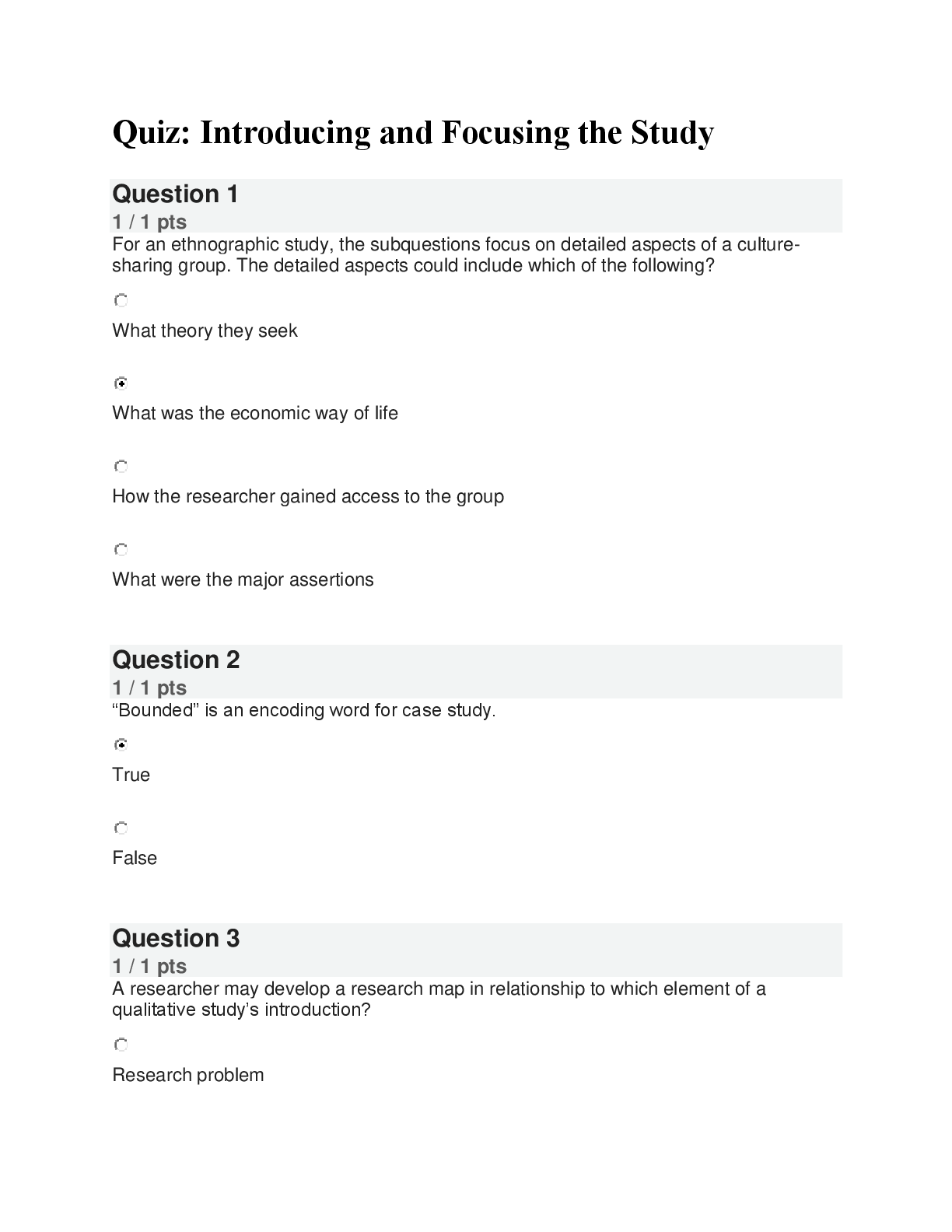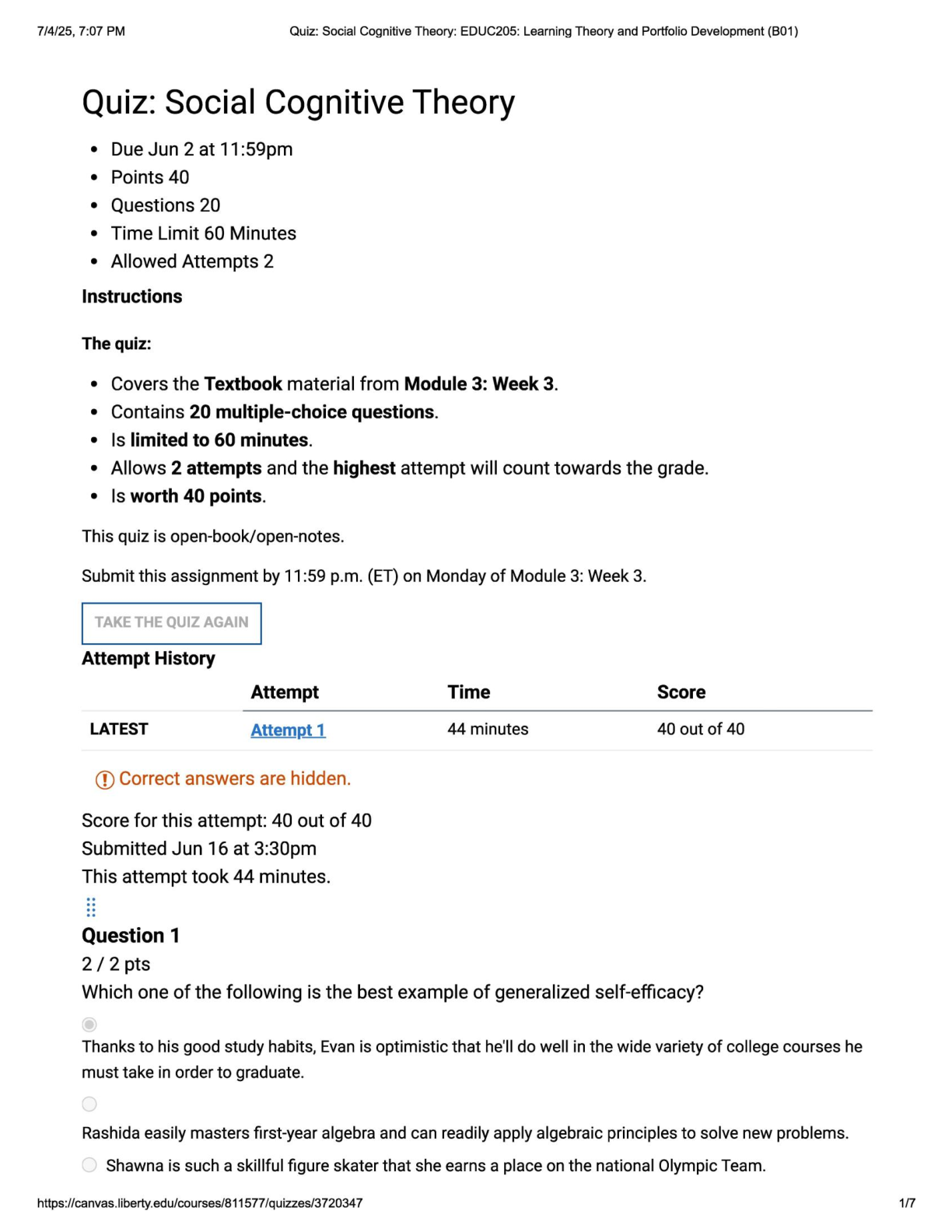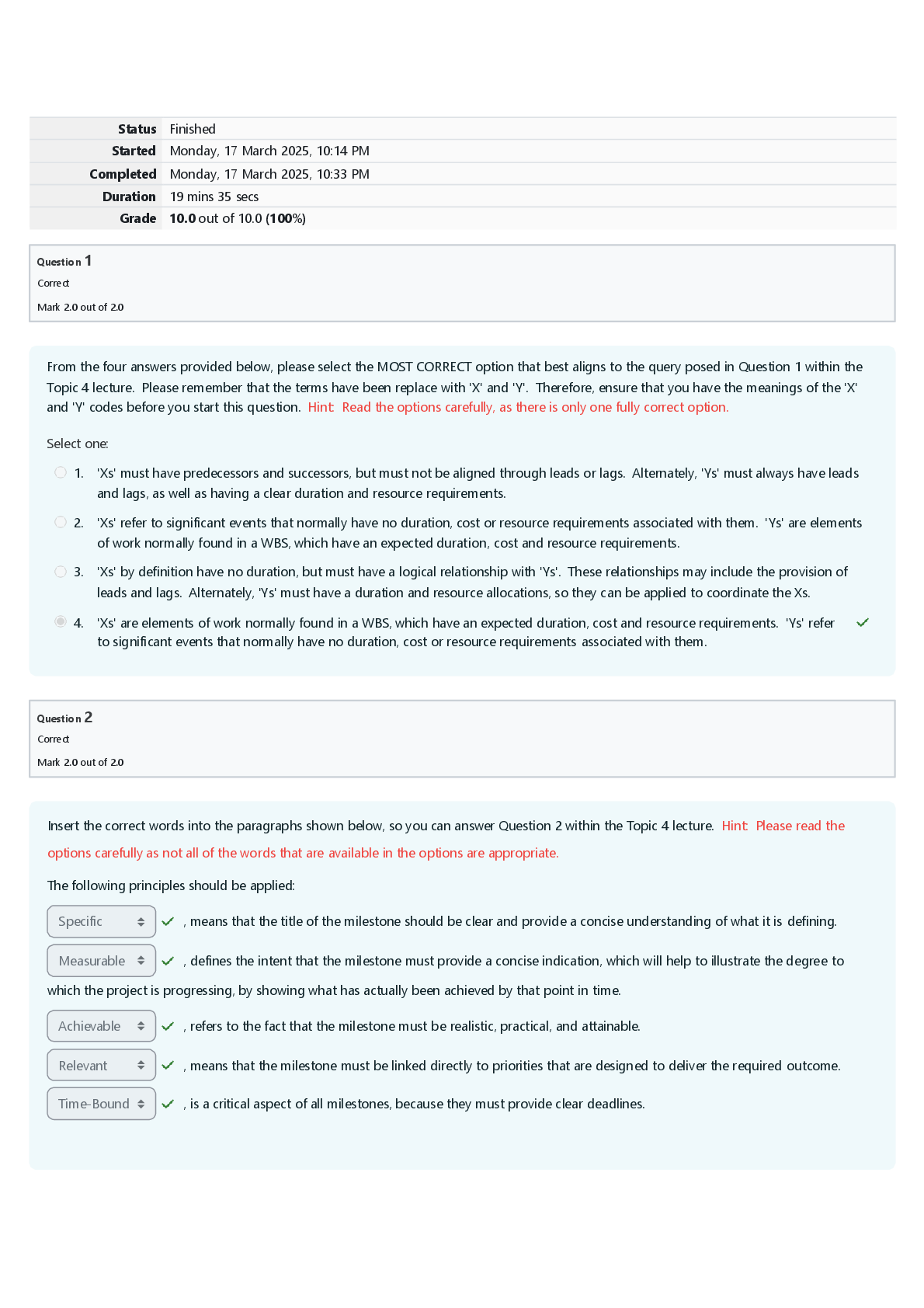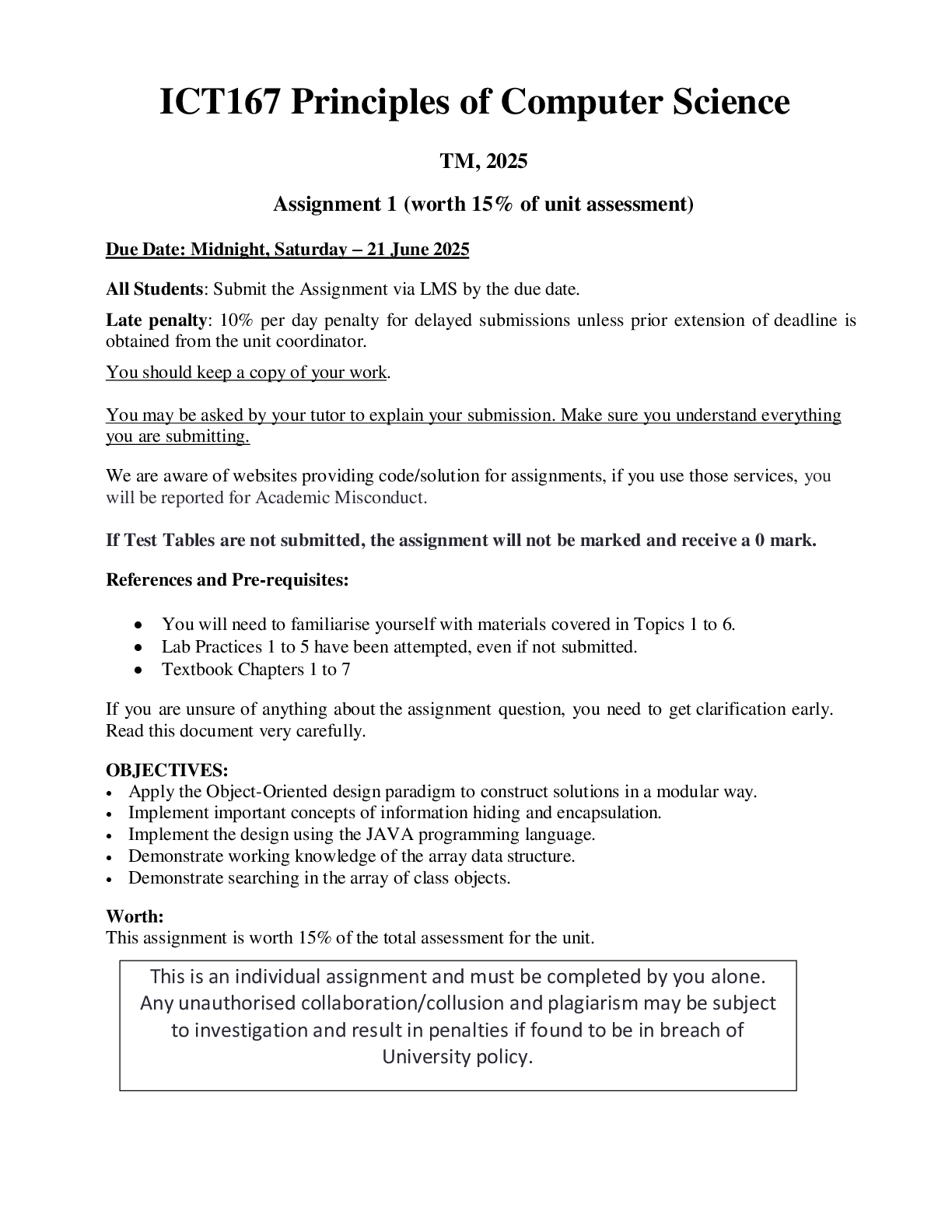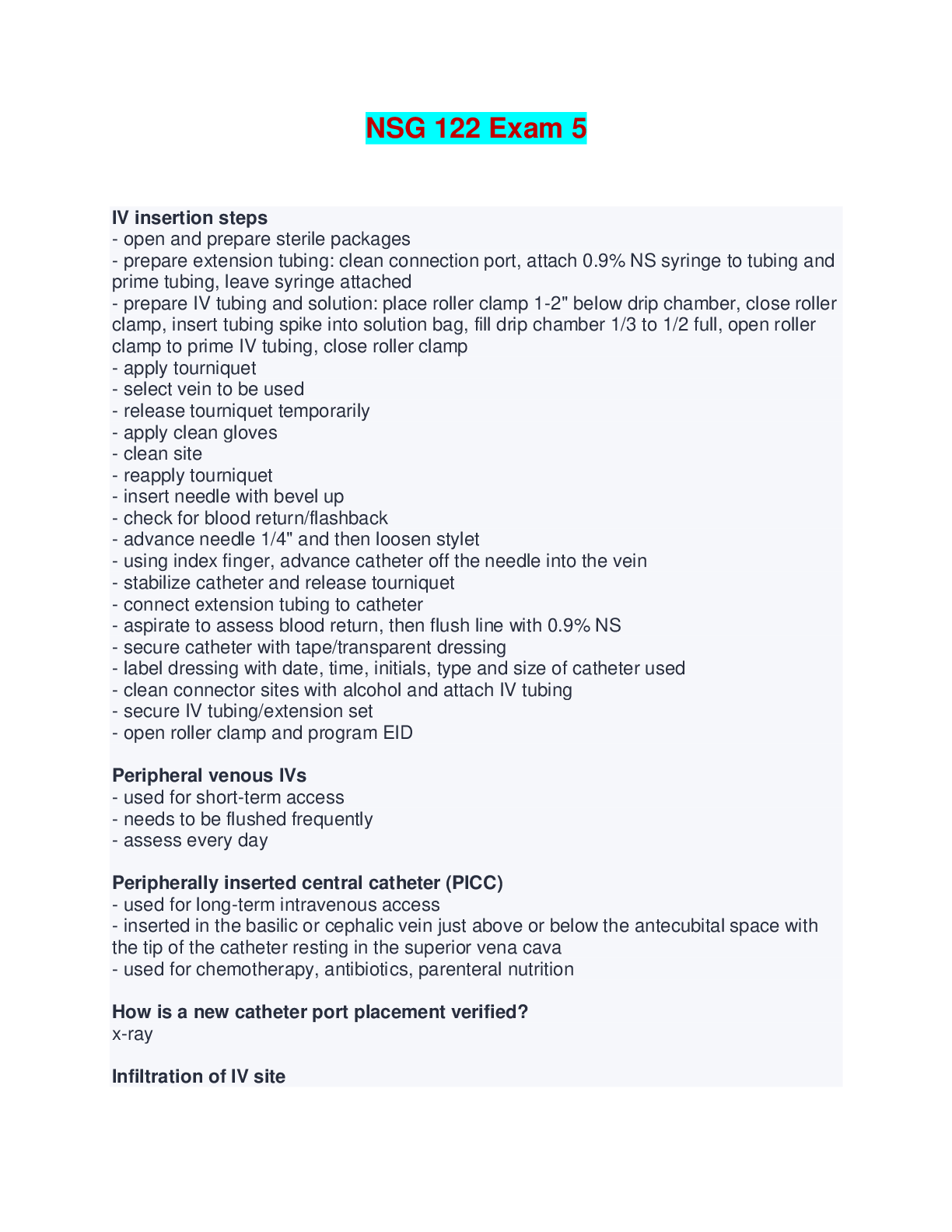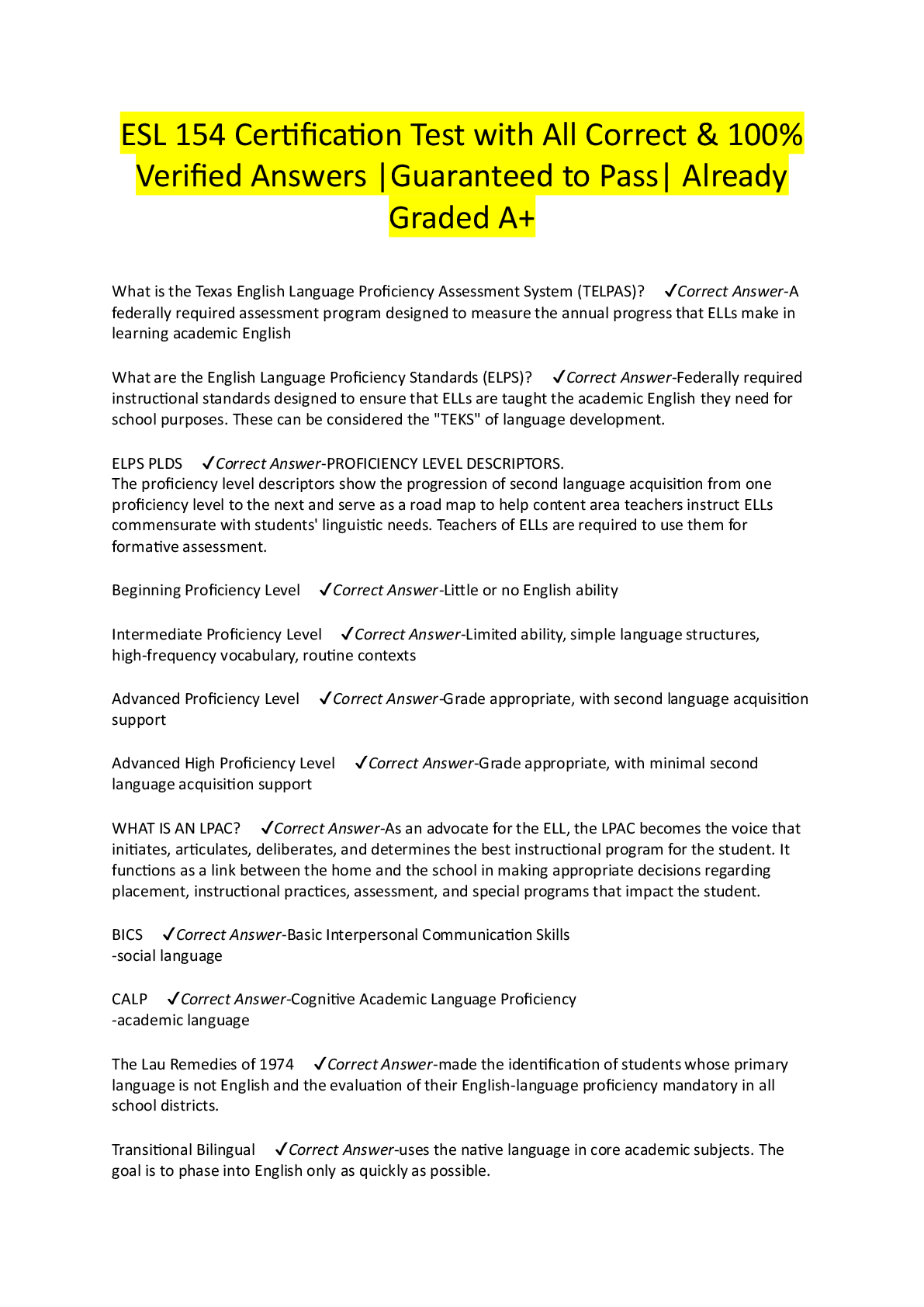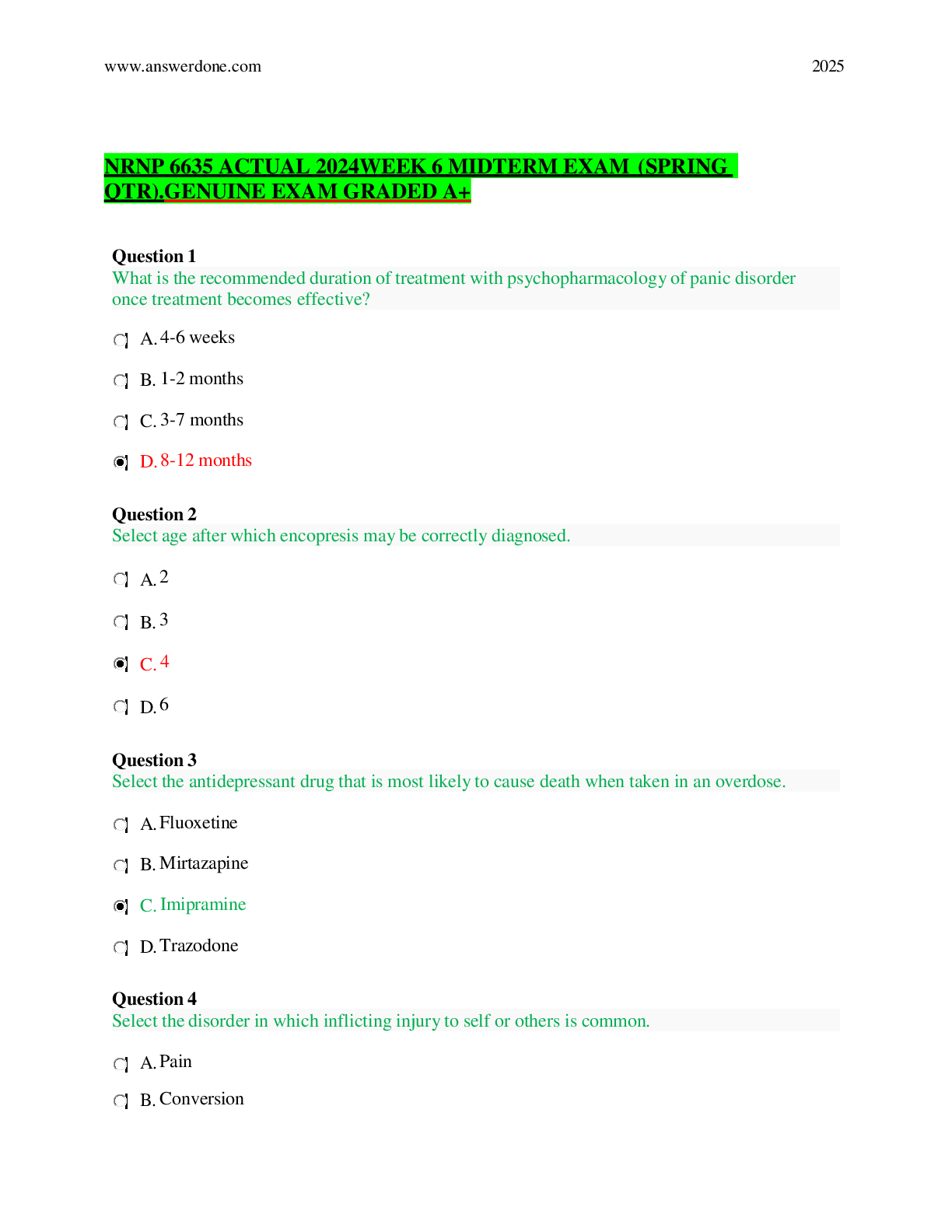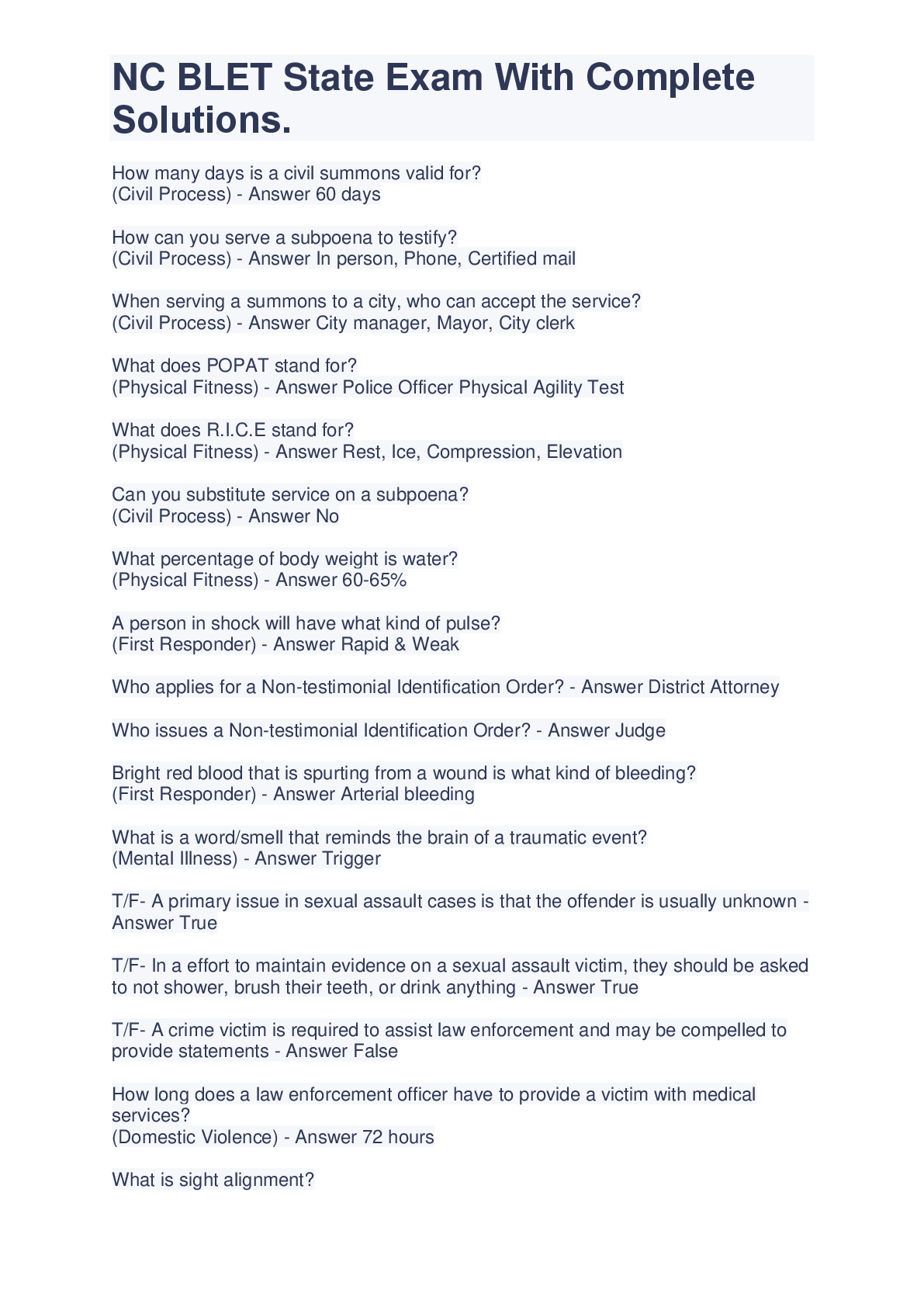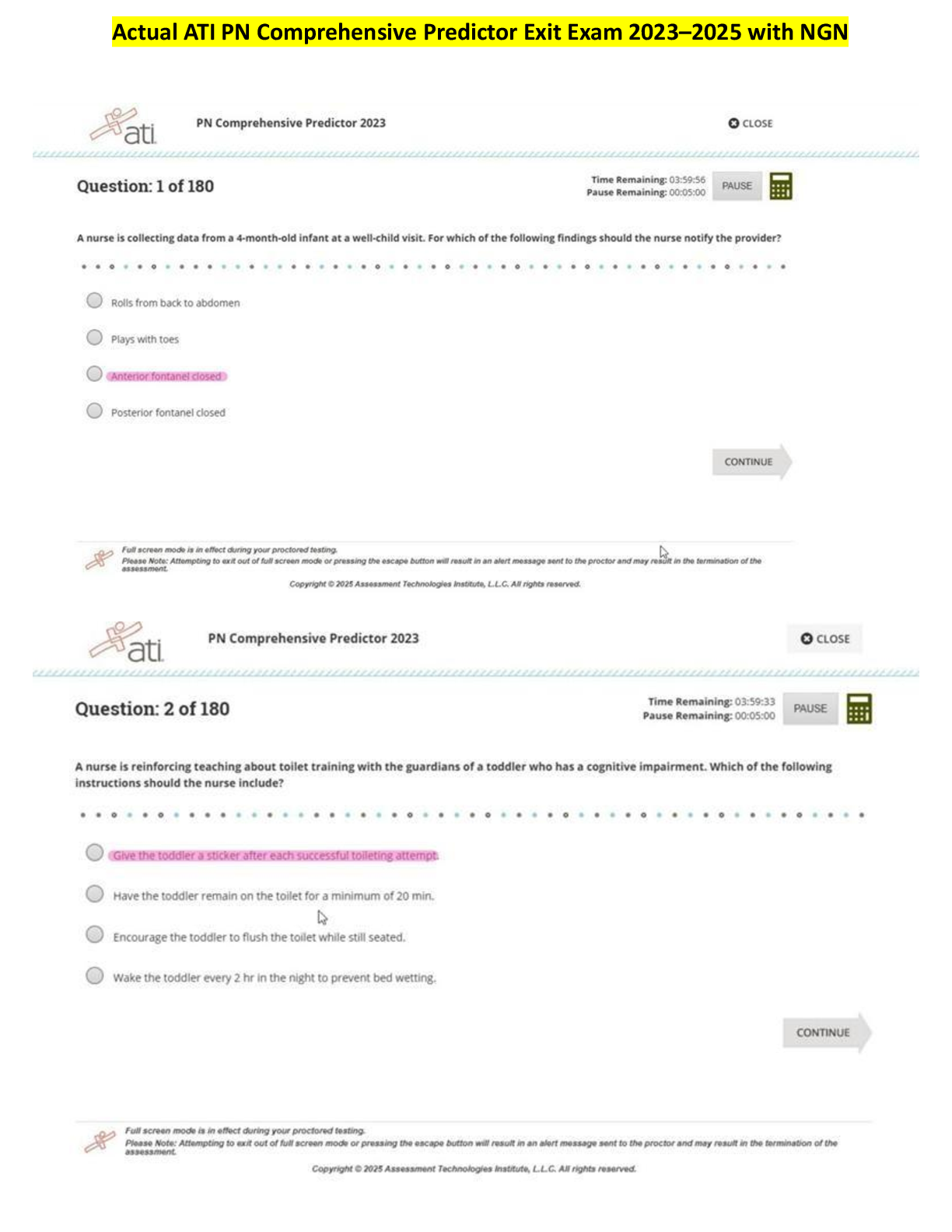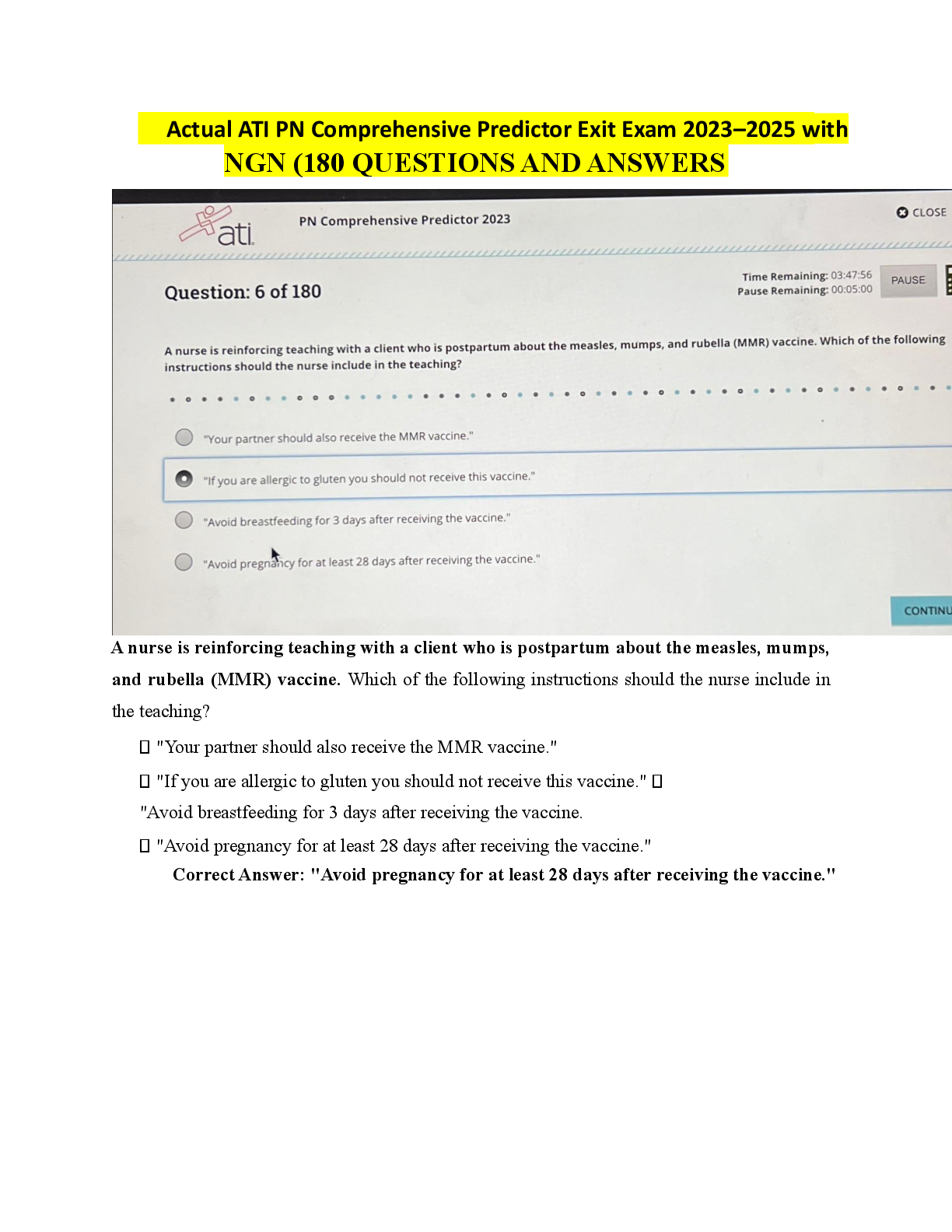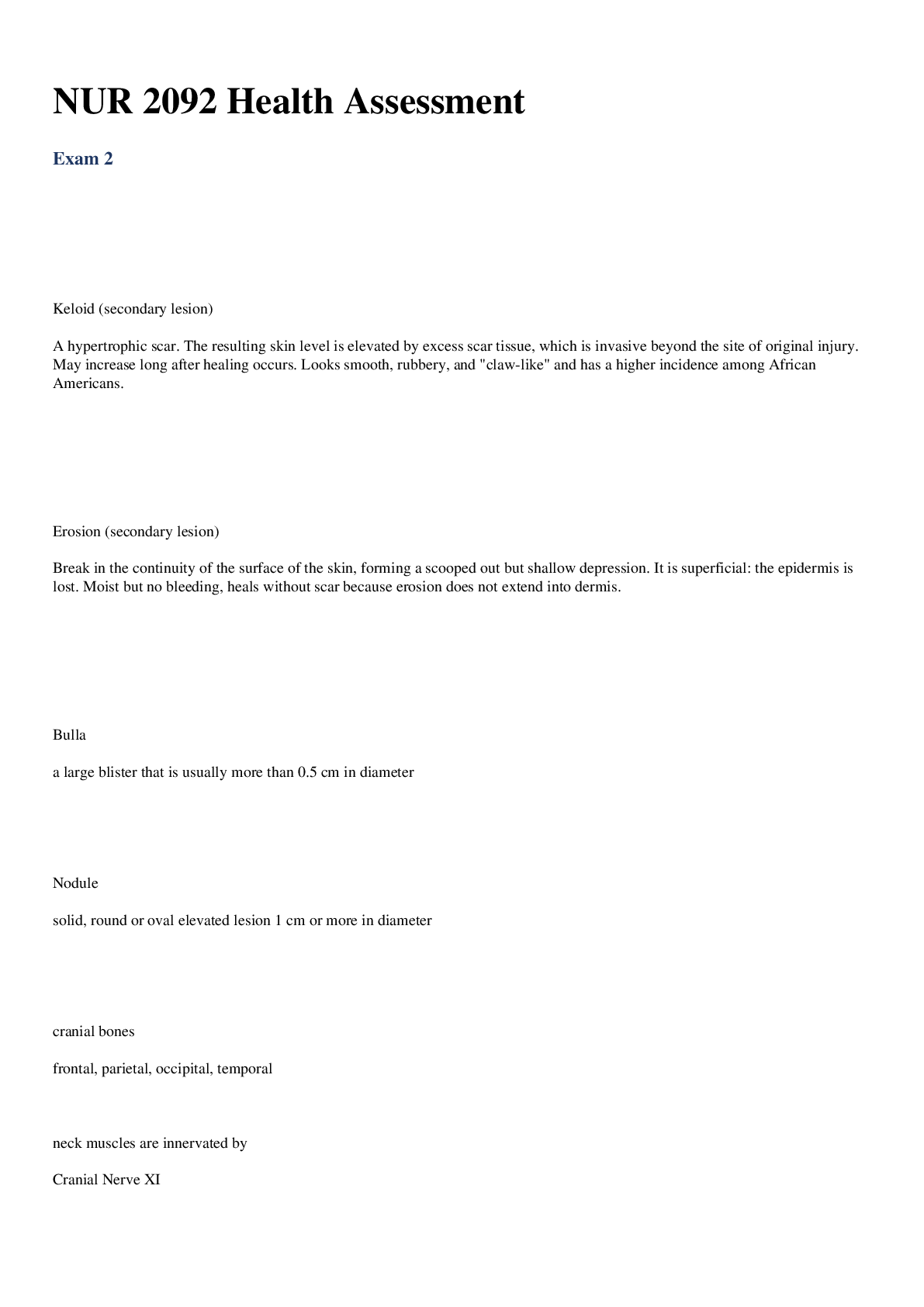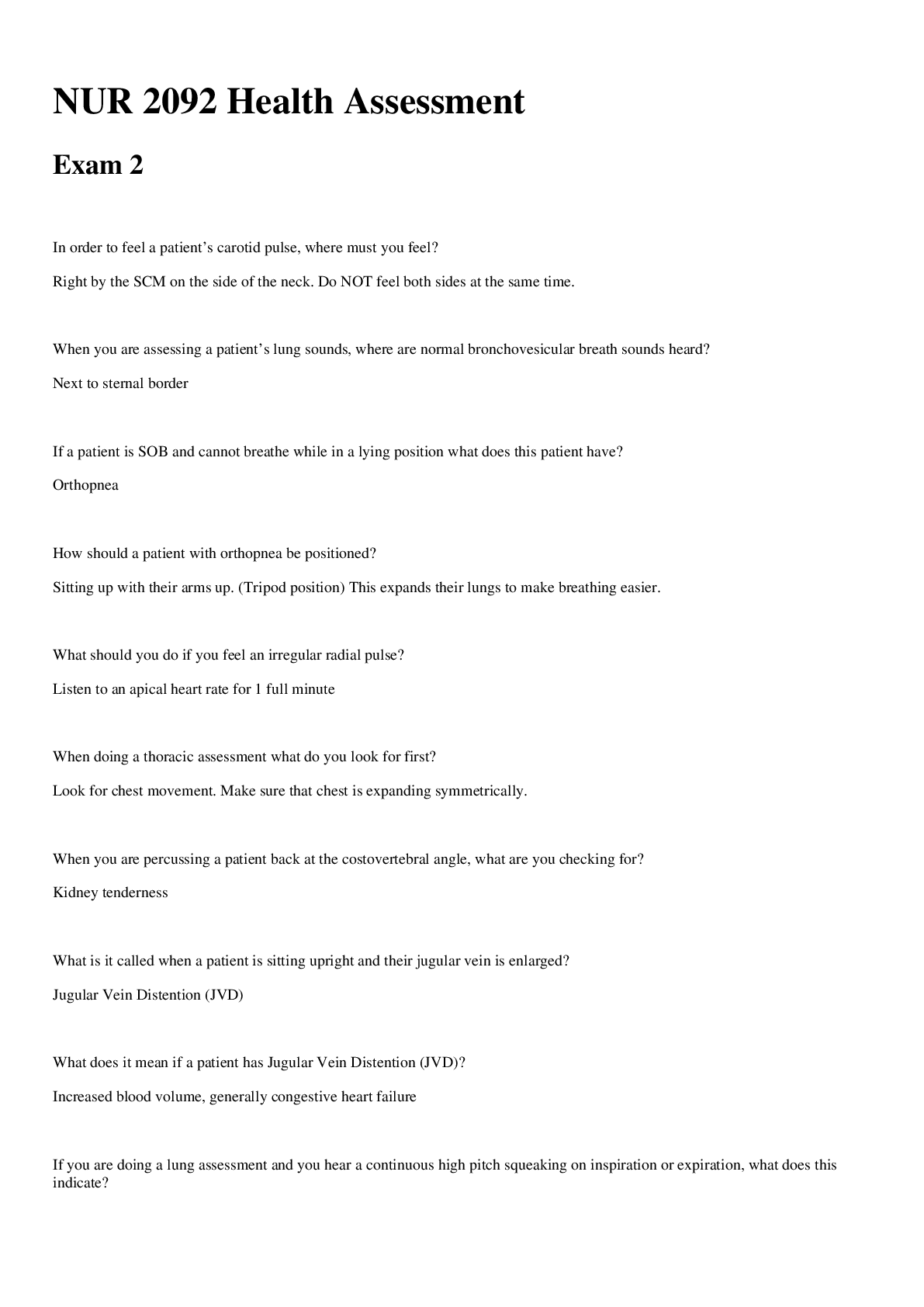ECDI 2271 - Chapter 5 Inviting Children's Participation in the Dramatic Arts
Document Content and Description Below
Chapter 5 Inviting Children's Participation in the Dramatic Arts Directions: Highlight the correct answer. 1) Creative drama helps children: 2) Enactment enables children to: 3) To rele ... ase children's creativity through drama, children need: 4) Older children who enact their own scripts base them on: 5) Theme corners or play centers make subjects real to children by: 6) To facilitate children's enactments, the teacher needs to do all of the following except: 7) Drama offers opportunities for children to improve their oral language skills because it: 8) Reader's Theater is particularly useful for all of the following except: 9) Puppets are powerful learning tools because: 10) Teachers should use story retelling in the primary grades to: 11) It is important for educators to teach the basic drama skills of: 12) Tableau includes all the following except: 13) Using puppets in the early childhood classroom involves providing: 14) Creative drama does not include: 15) Sociodramatic play has an important role in the development of young children because: 16) Puppets can be used as a medium for: 17) When using drama in the classroom, a teacher plays which important role? 18) Stories suitable for dramatization by young children generally contain: 19) An appropriate mime activity for intermediate children includes: 20) National theater standards include all of the following except: 21) A third-grade teacher wants her students to work in small groups to select one scene from an award-winning picture book and enact it for the class. Which of the following would be a recommended way to proceed? 22) In fourth-grade science, students are studying the use of simple machines. The teacher notices students are having difficulty relating the concept to real-life implementation of simple machines. What is one way the teacher could create science learning that relate to children's experience? 23) In the state assessment for third-graders, children must write a persuasive paragraph. A teacher introduces the concept of persuasion by discussing the strategies a child could use to convince her or his family that they should get a particular pet, toy, food item, or electronic device. The children work in groups focused on these four topics. Then, pairs of children write the script for a commercial. They will: (1) identify a product, (2) make a list of its advantages, and (3) use principles of advertising that they learned as part of media studies (e.g., celebrity endorsement or implying that the product will bring success and happiness). When a colleague questions the value of this activity, how could the teacher explain her reasoning? 24) After reading five different versions of The Three Little Pigs, what is one way a first-grade teacher can get the students involved in enactment? 25) A teacher read a story about a boy who was lost in the woods for hours before he was reunited with his family. The teacher asked the students to imagine how the little boy may have been feeling in the woods all alone. Which intelligence is being emphasized in this activity? 26) A group of preschool children at an urban child care center was on the playground when an ambulance with sirens and flashing lights arrived at the school. As the children stood at the fence, they saw the secretary being carried out on a stretcher; she had collapsed in the office and needed emergency medical treatment. Witnessing this incident led to many dramatizations in which peers and toys pretended to be injured and had to be taken to the hospital by ambulance. What category of enactment is this type of play? 27) A second-grade class was taking part in a bullying prevention session. Each group of five children was given a topic related to bullying and had to come up with a short skit to demonstrate the concept listed on their card. This type of drama teaches: 28) A first-grade teacher had her children act out a behavior without words; instead, they had to rely on such things as with hand gestures, body movements, and facial expressions. This is a description of: 29) Use the following choices to answer the items below. A. dramatic and sociodramatic play B. informal drama C. story or interpretive play D. formal or scripted drama 1. ___ ____ Pantomime and movement are examples of this type of creative drama. 2. ___ ___ When children enact a favorite story they have read or heard, they are engaging in this drama activity. 3. ___ ____ Preschool children typically engage in this kind of enactment. 4. ___ ____ A form of drama not recommended for preschool children. 5. ___ ____ Reader’s Theater is this type of drama. 30) Use the following choices to answer the items below. A. dramatic play B. pantomime C. puppets D. story drama E. reader’s theater F. D and E G. none of these 1. ___ ____ Children use make-believe to act out situations. 2. ___ ____ A presentation of a story or script based on a story by a group of readers. 3. ___ ____ Facilitates children's comprehension of a story read or heard. 4. ___ ___ Communicating ideas, feelings, and actions without words. 5. __ ____ A non-threatening tool for both teachers and children to enhance creative expression and view others in different roles. 6. __ ____ Re-enactment of familiar stories, poems, or fables. 7. ___ ___ Reciting a script from memory. 8. ___ ___ Non-verbal enactment. 9. __ ____ Enables children to act out social situations and express feelings informally. 10. __ ____ Re-creation of plot and dialogue of familiar characters and stories. 11. ___ ___ A form of drama that enables children to interpret a story script using facial and vocal expression in a non-staged performance. 31) Use the following choices related to the national arts standards to answer the items below. A. creating B. performing C. responding D. connecting 1. ___ ____ Preschoolers discuss the real and imaginary characters from a story they read, create uppets, and put on an improvised puppet show. 2. ___ ____ Preschoolers explore a unit on the zoo by discussing and enacting animal sounds and movies and how those sounds and movements provide clues for how the animals feel. 3. ___ ____ Preschoolers explore a weather unit by playing with clothing and props relevant to the different seasons 4. ___ ____ Children research, design, write, and perform commercials to exhibit material learned 5. ___ ____ Preschoolers assume roles, gather props, and enact family life play 6. ___ ____ Third and Fourth graders design and enact a talk show to review a recent historical concept covered in class. Directions: Choose TRUE or FALSE for the statements below. 32) Creative drama is a learning tool for all children. Answer: 33) Story play is based on the idea that children can learn to read and write more easily if they use an author's published book for children. Answer: 34) Story drama, informal drama, and dramatic play help develop children's self-confidence. Answer: 35) Experiencing drama early helps children appreciate drama as an art form. Answer: 36) The teacher's role in dramatic play is not important. Answer: 37) The most appropriate drama activities for early childhood are unrehearsed, informal, and process-oriented. Answer: 38) Using prop boxes and theme corners hinders the spontaneity of dramatic play. Answer: 39) Children can and should help plan and create theme corners. Answer: 40) Pantomime is valuable for children who are shy, have speech or hearing problems, or are non-English speaking. Answer: 41) Instruction is not necessary for younger children to be successful with pantomime. Answer: 42) Story drama should not be used with poor readers. Answer: 43) By using drama activities in subject areas, children come to understand abstract ideas more concretely. Answer: 44) Drama cannot easily be integrated throughout subject areas. Answer: 45) Child-centered early childhood curricula do not lend themselves to the incorporation of drama. Answer: 46) Opportunities for drama belong everywhere in the early childhood curriculum. Answer: 47) Drama activities usually exclude second language learners because these students have limited proficiency with English. Answer: 48) Enactment is when young children take on behaviors, actions, and thoughts of someone in a particular situation. Answer: 49) Early dramatic play experiences help children to appreciate drama as they mature. Answer: 50) Story play often includes reading and reenacting a published story. Answer: 51) When incorporating drama into the classroom, it is advisable to include children in the selection of the story. Answer: 52) An appropriate activity for intermediate children includes role-playing conflicts in a story and discussing and performing different resolutions. Answer: 53) Teachers should coax shy children into participating in drama activities. Answer: 54) Drama activities, such as body movement, choral speaking, and pantomime, utilize children's concentration without the pressure of verbalization. Answer: [Show More]
Last updated: 3 years ago
Preview 1 out of 8 pages

Buy this document to get the full access instantly
Instant Download Access after purchase
Buy NowInstant download
We Accept:

Also available in bundle (1)
Click Below to Access Bundle(s)
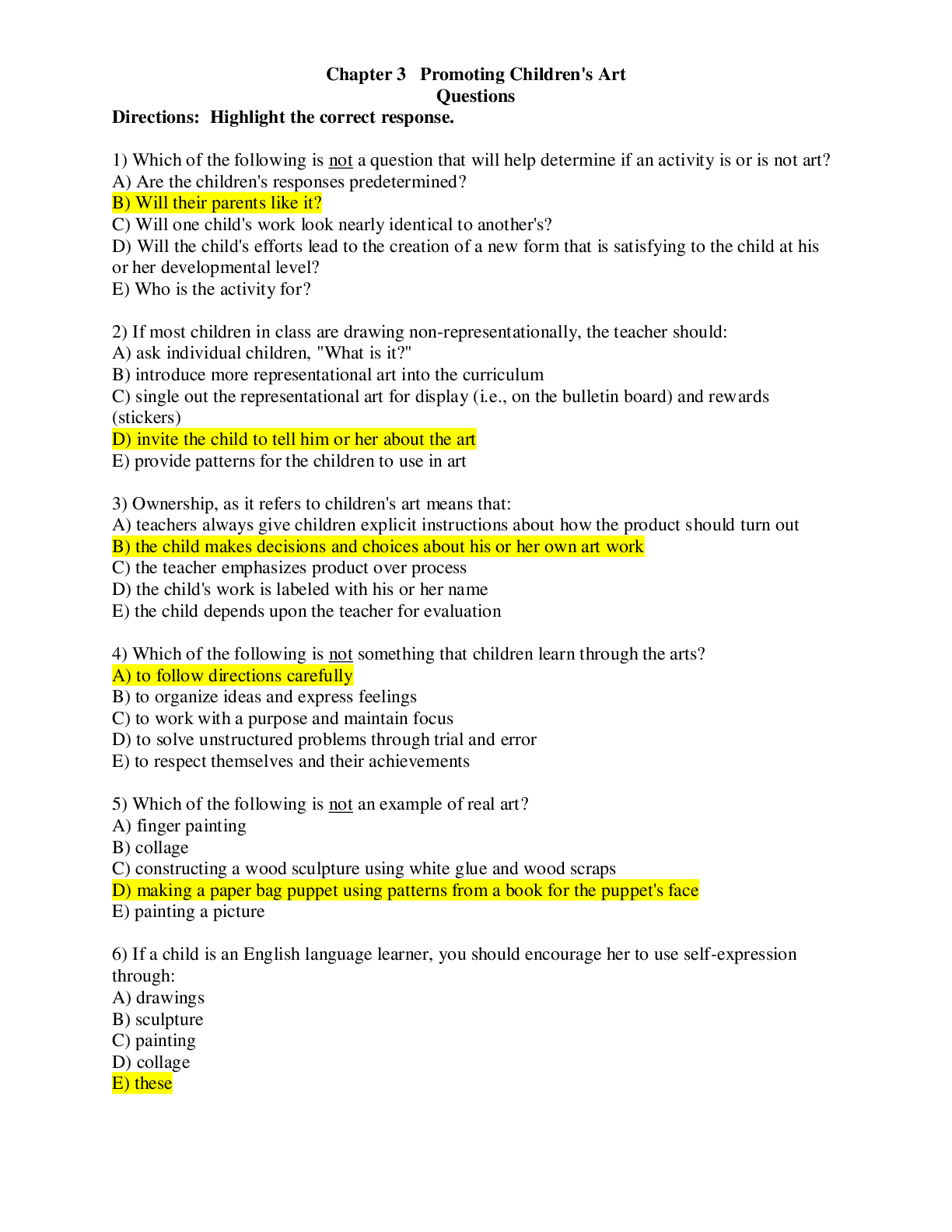
EDCI 2271 - Art Education for Elementary Schools
Chapter 7 Assessing the Creative Processes & Products of Children|Chapter 5 Inviting Children\'s Participation in the Dramatic Arts| Chapter 8 Children\'s Creative Work in Diverse Families and Communi...
By Ajay25 4 years ago
$30
7
Reviews( 0 )
$13.50
Can't find what you want? Try our AI powered Search
Document information
Connected school, study & course
About the document
Uploaded On
Feb 26, 2021
Number of pages
8
Written in
All
Additional information
This document has been written for:
Uploaded
Feb 26, 2021
Downloads
0
Views
151


